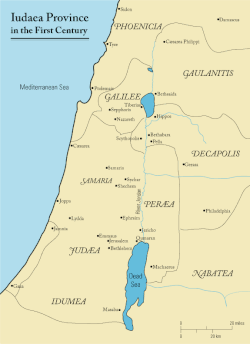Iudaea province
| Provincia Iudaea | |||||
| Province of the Roman Empire | |||||
|
|||||
| Capital |
Caesarea Maritima 32°30′N 34°54′E / 32.500°N 34.900°ECoordinates: 32°30′N 34°54′E / 32.500°N 34.900°E |
||||
| Prefects before 41, Procurators after 44 | |||||
| • | 6–9 CE | Coponius | |||
| • | 26–36 CE | Pontius Pilate | |||
| • | 64-66 CE | Gessius Florus | |||
| • | 117 CE | Lusius Quietus | |||
| • | 130-132 CE | Tineius Rufus | |||
| King of the Jews | |||||
| • | 41–44 | Agrippa I | |||
| • | 48–93/100 | Agrippa II | |||
| Legislature | Synedrion/Sanhedrin | ||||
| Historical era | Roman Principate | ||||
| • | Census of Quirinius | 6 CE | |||
| • | Crisis under Caligula | 37–41 CE | |||
| • | Incorporation of Galilee and Peraea | 44 CE | |||
| • | Destruction of the Second Temple | August 4, 70 CE | |||
| • | Governor of praetorian rank & given the 10th Legion | c.74 CE | |||
| • | Bar Kokhba revolt | 132–135 CE 135 CE | |||
| Today part of |
|
||||
| Before August 4, 70 is referred to as Second Temple Judaism, from which the Tannaim and Early Christianity emerged. | |||||
The Roman province of Judea (Hebrew: יהודה, Standard Yehuda Tiberian Yehûḏāh; Arabic: يهودا; Greek: Ἰουδαία; Latin: Iūdaea), sometimes spelled in its original Latin forms of Judæa, Judaea or Iudaea to distinguish it from the geographical region of Judea, incorporated the regions of Judea, Samaria and Idumea, and extended over parts of the former regions of the Hasmonean and Herodian kingdoms of Israel. It was named after Herod Archelaus's Tetrarchy of Judea, but the Roman province encompassed a much larger territory. The name "Judea" was derived from the Kingdom of Judah of the 6th century BCE.
Judea province was the scene of unrest at its founding in 6 CE during the Census of Quirinius and several wars were fought in its history, known as the Jewish–Roman wars. The Temple was destroyed in 70 CE as part of the Great Jewish Revolt resulting in the institution of the Fiscus Judaicus, and after Bar Kokhba's revolt (132–135), the Roman Emperor Hadrian changed the name of the province to Syria Palaestina and Jerusalem to Aelia Capitolina, which certain scholars conclude was an attempt to remove the relationship of the Jewish people to the region.
...
Wikipedia

